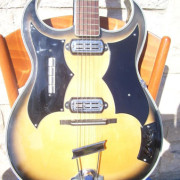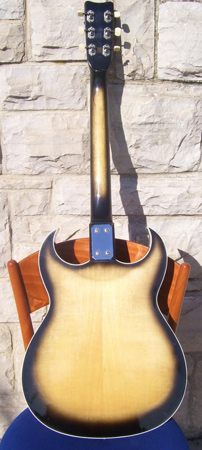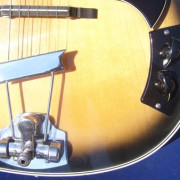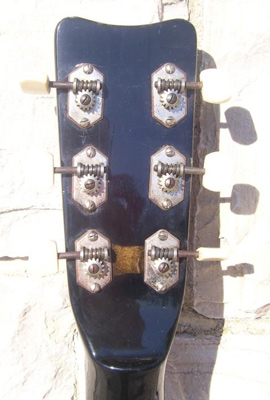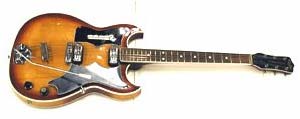Crucianelli Florentine
1964 Éliteearliest version
Crucianelli double Florentine cutaway guitars are surprinsingly many in Sweden. Not by chance. Hagström, the big local guitar manufacturer, was also a leading distributor of musical gear. The company runned Sweden’s largest chain of music shops, had at a time up to 45 stores covering the whole country, with subsidiaries in Norway and Denmark. In the 60’s they offered in addition to Hagström-made guitars (and accordions) various instruments sourced from other makers, including the whole Fender range (Hagström had exclusive distribution rights for Scandinavia), acoustic guitars made in the South of Sweden by the Bjärton company, and semi-acoustic guitars from Italy made by Crucianelli.
Being also responsible for all Bjärton’s export sales, Hagström was in the middle of a large transatlantic trade network. Acoustic guitars made by Bjärton were sold worlwide with the Hagström logo. In the U.S. Hagström selled also them by thousands to Fender, who marketed them under the name Tarrega (1962-1966), and to the B&J company who used the nameEspaña. This is most likely through this connection that Crucianelli guitars also landed on the U.S. market with the España logo on their peghead.
At the time Crucianelli had started manufacturing semi-acoustic guitars, Hagström’s own 335-inspired model was still under development (the Viking, made available during winter 1964-65). So it was to alleviate a temporary lack in the selling program that in 1964, in front of the rising demand for thinline hollowbodies, Hagström took in distribution guitars from Crucianelli. Of course not the 335 copies (except early versions), they were too close to the Viking specs. The Florentines on the other hand could bring a welcome addition to the assortment Hagström retailed in Scandinavia, they had a different appearance, they were available with a whammy and would soon be fitted with humbuckers, both features the Viking didn’t have yet.
The Élite shown here is a splendid example of Crucianelli Florentine from the first production run. The endless whammy bar is there! Similarities with thecontemporaneous prototype of 335-style Élite are many : no f-holes, rocker switch controls above pickups, and same small narrow headstock. Differences are in the fretboard (dots, soon to be substituted by MOP block-inlays) and the control panel that makes a quite cool symmetry effect with the pickguard.
Jack Marchal
Italiano
Le Crucianelli fiorentine a due spalle mancanti sono stranamente frequenti in Svezia. Non a caso. Il grande costruttore locale di chitarre Hagström era anche il principale distributore di strumenti musicali, gestiva la più grande catena di negozi di musica in Svezia, ebbe un tempo fino a 48 punti vendita che coprivano tutto il paese, con succursali in Norvegia e Danimarca.
Negli anni 60 oltre le chitarre (e fisarmoniche), Hagström vendeva diversi strumenti di altri produttori, tutta la gamma Fender (Hagström aveva i diritti esclusivi di distribuzione per la Scandinavia), chitarre acustiche fatte nella Svezia meridionale dall’azienda Bjärton, e semi-acustiche italiane di Crucianelli.
Visto che Hagström si incaricava anche di tutta l’attività di esportazione di Bjärton, la ditta era al centro di una importante rete di scambi commerciali. Le acustiche fatta da Bjärton erano vendute nel resto nel mondo con il logo Hagström. In USA Hagström le rivendeva a migliaia a Fender, il quale le commercializzava sotto l’etichetta Tarrega (1962-1966), e alla compagnia B&J, che le rinominava España. E’ con ogni probabiltà che attraverso questa connessione, delle chitarre Crucianelli arriveranno sul mercato americano con il logo España sulla paletta.
Nel momento in cui Crucianelli stava iniziando la produzione delle sue semi-acustiche, il modello Hagström ispirato dal tipo 335 era ancora in fase di progettazione (la Viking, introdotta durante l’inverno 1964-65). Quindi fu per rimediare a una mancanza temporanea nel programma di vendita che nel 1964, di fronte alla domanda crescente di semi-acustiche, Hagström prese in distribuzione quelle di Crucianelli. Non il tipo 335 (a parte le versioni iniziali), che era troppo vicino alle specifiche della Viking. Le fiorentine invece potevano allargare in modo opportuno l’assortimento distribuito in Scandinavia da Hagström. Avevano un aspetto diverso, erano disponibili con vibrato ed erano sul punto di essere proposte con humbuckers, due caratteristiche ancora assenti dalla serie Viking.
La Élite mostrata qui è uno splendido esempio di Crucianelli fiorentina della prima serie. L’interminabile leva c’è! Ci sono molte similarità con il prototipo contemporaneo di Élite tipo 335 : niente buche a effe, pulsantiere sopra i pickups, e la stessa paletta dimagrita. Le differenze sono sulla tastiera (punti, in attesa di essere cambiati con i segnatasti madreperlati quadrati) e la piastra dei controlli che di fronte al battipenna da un effetto di simmetria veramente cool.


